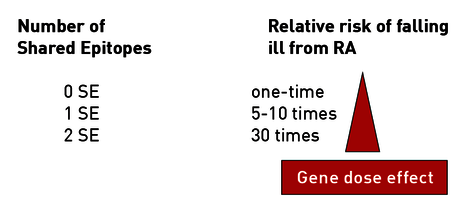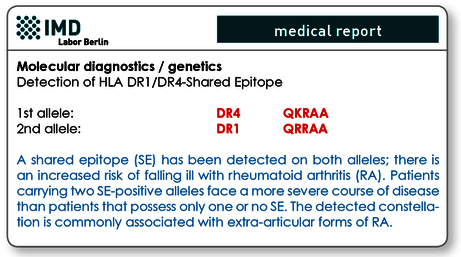HLA-DR4/DR1 “Shared Epitope”- Detection of Rheumatoid Arthritis
| There is a close connection between some HLADR alleles coding so-called shared epitopes and rheumatoid arthritis. This connection has been substantiated some time ago. Molecular-biological tests can detect the specific amino acid motives of shared epitopes and help determine the HLA-DR status. This in turn provides detailed information regarding the individual probability of developing rheumatoid arthritis, the prospective course of disease, and likely treatment response. |
Clinical relevance of the shared epitope (SE)
Rheumatoid arthritis (RA) possesses a prevalence of 1 % and is the most common inflammatory systemic disease regarding joints in Germany. In severe cases, RA can lead to premature invalidity within a short period of time. Hence, early diagnosis and prognosis are vital in order to initiate suitable therapy and avoid consequential damages. There is a clear genetic pre-disposition regarding RA due to some HLA-DR4 sub-types. Associated with the disease are primarily some HLA-DR4 sub-types as well as some additional sub-types of HLA alleles DR1, DR10, DR11, and DR14. All of the RAassociated HLA-DR alleles code the so-called shared epitopes (SE), which are amino acid motives QKRAA, QRRAA or RRRAA. SEs have been detected in ca. 90 % of RA patients. The prevalence in individuals without RA is ca. 20-30 %. In case of existing SEs, the risk of falling ill from RA is 5-10 times higher in patients with one copy, while patients with two copies possess an elevated risk of up to 30 %.

Fig. 1 The risk of developing a rheumatoid arthritis increases significantly with the number of HLA characteristics carrying shared epitopes. In addition, patients carrying two SE-HLA characteristics often face quicker and more severely progressing RAs than patients with only one or no SE (gene dose effect).
Hence, the detection of shared epitopes at an early stage can render the diagnosis a lot easier. The existence of a shared epitope is is an important prognostic marker regarding future progress and severity, since there is a clear connection between HLA-DR status, SE type and the disease’s course. A gene dose effect has also been detected in patients, who are carriers of two disease-associated SE alleles. These patients suffer from a more severe course of the disease more often than patients with just one or no SE-HLA allele. Especially shared epitopes of HLA allele DR4 are predicative regarding a more progressive and destructive RA form with extra-articular organ manifestations.
The detection of shared epitopes provides information for drug-related therapy
With regard to medical treatment it has turned out that RA patients with SEs do respond more often to a combination therapy with Methotrexate-Hydroxychloroquine-Sulfonamide (94 % responder) than to a Methotrexate mono-therapy (32 % responder). Patients with two SE alleles usually respond better to Etanercept (76 %) than to Methotrexate (48 %). In patients with one SE-HLA allele, the response regarding Etanercept is comparable to that of Methotrexate (41 %).
Indication
- Detection and differentiation of clinically unclear cases of RA
- Choice of therapy
- Treatment optimisation
- Family history of rheumatoid arthritis

HLA-association regarding the antibiotic-resistant course of Lyme disease (borreliosis)
It is a well-known fact that patients with HLA-DR2 or –DR4 possess a genetic predisposition regarding the development of antibiotic-resistant Lyme borreliosis (relative risk: 22- fold!). Latest research has shown that HLA-DR associations are not limited to so-called shared epitope-carrying HLA-DR alleles. Hence, in order to identify risk patients regarding the development of a therapy-resistant borreliosis, it is recommended to administer HLA-DR sub-typing. For further information, please read our diagnostic information No. 214; „What ist he added value of HLA determination regarding diagnostics and assessment of the borreliosis’ course?
Material
2 ml EDTA blood
Transport to the laboratory is not time-sensitive and can be sent by mail.
Invoicing
Please obtain the costs of the test from the pdf-document.
Literatur
- O’Dell JR et al. HLA-DRB1 typing in rheumatoid arthritis: predicting response to specific treatments. Ann Rheum Dis 1998;57:209
- Newton JL et al. A review of the MHC genetics of rheumatoid arthritis. Genes and immunity 2004;5:151
- Criswell LA et al. The influence of genetic variation in the HLA-DRB1 and LTA-TNF regions on the response to treatment of early rheumatoid arthritis with methotrexate or etanercept. Arthritis Rheum. 2004; 50(9):2750
